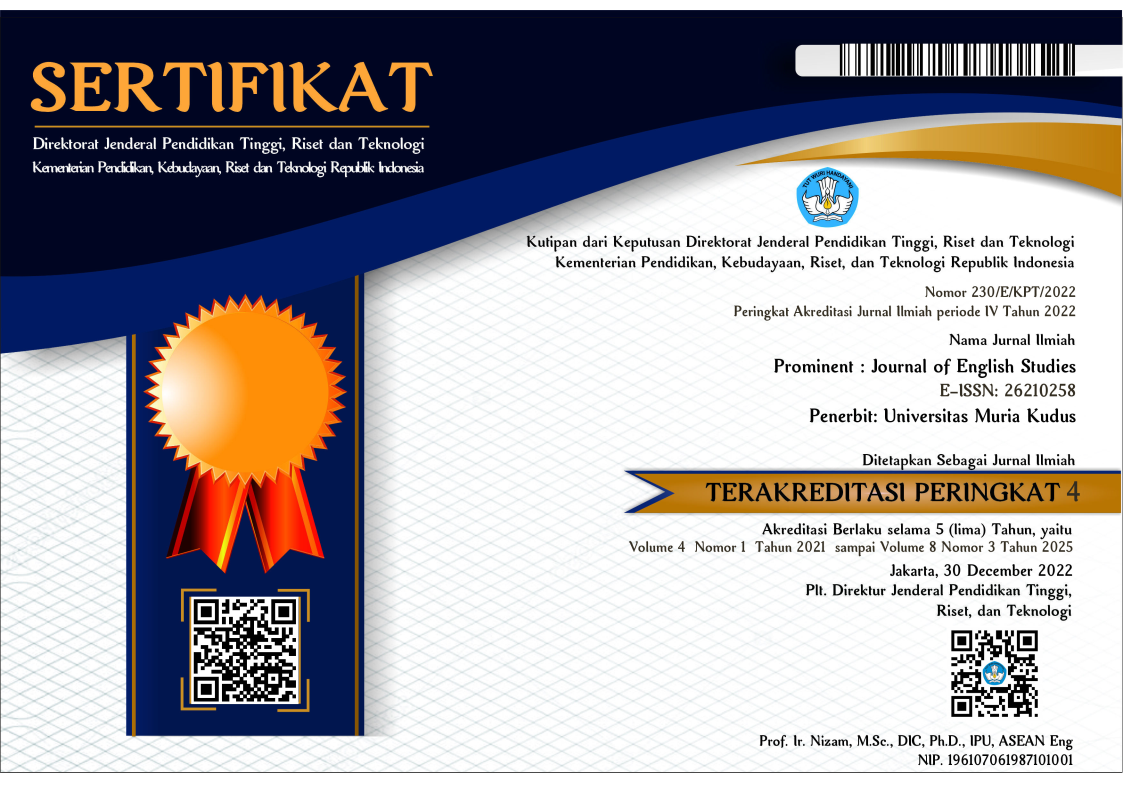An interpersonal meaning analysis of the EFL student's talk in learning Descriptive Text at Junior High School
Abstract
Abstract: Language is a type of action that is utilized to serve human needs by communicating information. It is concerned with interpersonal meaning or language-based human expressions. SFL analysis is significant to master in the grammatical field because it provides an overview for analyzing and interpreting the meaning of a written or spoken text. This study analyzed a conversation by student and teacher in learning writing descriptive text using interpersonal meaning. The aim of this study is to identify the mood system contained in transcript conversation students and teacher in junior high school. This study employed qualitative research due to the written form of analysis, and focused on analyzing speech function and the mood system that includes declarative mood, interrogative mood, exclamative mood and imperative mood. The findings of this study showed of the mood system contained in declarative mood, interrogative mood, exclamative mood and imperative mood. This showed that conversation student and teacher being analyzed contains information according to the function of the declarative mood, interrogative mood, exclamative mood and imperative mood, which is to describe information through a statement. Researcher found modality is probability, obligation, inclination, usuality in the data. Researcher for conversation, students, and teachers can better comprehend the underlying meanings and intentions conveyed through communication with the support of an in-depth knowledge of interpersonal meaning, which builds the interpretation and analysis of a variety of communication objects
Keywords
References
REFERENCES
Alyfia, H., & Setiarini, N. L. P. (2019). The Interpersonal Meaning Analysis of Michelle Obama’s Speech. Jurnal Kata: Penelitian Tentang Ilmu Bahasa Dan Sastra, 4(2). http://ejournal.lldikti10.id/index.php/kata/article/view/4504
Brillianta, C., & Putu, S. N. L. (2022). Interpersonal Functions of Joe Biden’s Campaign Speech Transcript: A Systemic Functional Linguistics Approach. Sphota, 14(2), 67–78. https://doi.org/10.36733/sphota.v14i2.2663
Butt, D., Feez, R., Spinks, S., & Yallop, C. (2001). Using Functional Grammar An Explorer’s Guid. New South Wales: Southdown Press Pty Ltd.
Eggins, S. (2004). An introduction to systemic functional linguistics. London: Continuum International Publishing Group.
Gerot, L., & Wignell, P. (1995). Making sense of functional grammar : an introductory workbook. http://ci.nii.ac.jp/ncid/BA32511896
Hadiani, D. (2019). Interpersonal meaning in students‟ explanation texts. JELE (Journal of English Language and Education), 5, 12–20.
Halliday, M. (2013). Halliday’s Introduction to Functional Grammar. In Routledge eBooks. https://doi.org/10.4324/9780203431269
Halliday, & Martin. (1981). Readings in systemic linguistics. London: Trafalgar Square Publishing.
Halliday, & Matthiessen. (2014). Halliday’s introduction to functional grammar 4rd edition. London: Odder Education.
Ivanic, R. (1998). Writing and Identity: The Discoursal Construction of identity in Academic Writing. Amsterdam: John Benjamins.
Ivanic, R., & Camps, D. (2001). I am How I Sound: Voice as Self-Representation in L2 Writing. Journal of Second Language Writing, 10, 3–33.
Martin, J. P., & White, P. S. (2005a). The Language of Evaluation: Appraisal in English. In Palgrave Macmillan eBooks. http://community.hciresearch.org/sites/community.hciresearch.org/files/LanguageofEvaluationBook.pdf
Martin, J. P., & White, P. S. (2005b). The Language of Evaluation: Appraisal in English. In Palgrave Macmillan eBooks. http://community.hciresearch.org/sites/community.hciresearch.org/files/LanguageofEvaluationBook.pdf
Mulatsih, S., & Sunardi, S. (2021). Types of Mood Used By the Lecturer in Teaching Reading: a Systemic Functional Linguistic Analysis. Prominent. Prominent: Journal of English Studies, 4(1). https://jurnal.umk.ac.id/index.php/Pro/article/view/5778
Thompson, G. (2014). Introducting Functional Grammar : Third Edition. New York: Routledge. https://otomasi.untidar.ac.id/otomasi/index.php?p=show_detail&id=8094
Vrika, R., Mujiyanto, J., & Suwandi, S. (2019). The Realization of Interpersonal Meaning in the Report Text of the Undergraduate Students of Universitas Batanghari Jambi. English Education Journal, 9(4), 492–500. https://doi.org/10.15294/eej.v9i4.31907
Wiyanto, M. S. (2020). Using Speech Function on EFL Classroom. ENGLISH EDUCATIONJournal of English Teaching and Research, 5(2), 143–148. https://ojs.unpkediri.ac.id/index.php/inggris/article/view/14662/1764
Xiaoyan, T., & Yu, Z. (2022). An Analysis of Interpersonal Meaning of an English Advertisement. Sino-US English Teaching, 9(1). https://doi.org/10.17265/1539-8072/2022.01.002
DOI: https://doi.org/10.24176/pro.v7i1.10551
Refbacks
- There are currently no refbacks.
Prominent Journal of English Studies is licensed under a Creative Commons Attribution-ShareAlike 4.0 International License.
Dedicated to:

in Collaboration with APSPBI:





